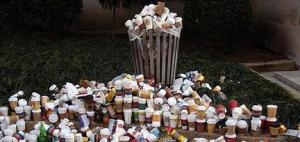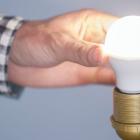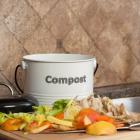Join the Mug Movement! Say No to Disposable Coffee Cups
Submitted by Trista Dorscher on | Updated Sat, 17/09/2016 - 23:49

Annually, over 500 billion disposable cups are being manufactured across the globe. Canada and the US are major culprits for this manufacturing mayhem. It was estimated that in the United States alone, 58 billion disposable cups are discarded to the landfill each year. This number may be hard to visualize at first, but think about it. How many hot beverages do you buy a week on average? And what are you drinking them in?
There are many different types of drinking cups out there, both disposable and re-useable varieties, so which one is the most environmentally friendly option?
1. Disposable Paper Cups
Due to health regulations and paper manufacturing, the majority of paper cups are less than 10% post-consumer products. This means each cup uses 90% virgin pulp to be produced. Not only is that a lot of paper, but it adds up to be a lot of carbon emissions as well. Manufacturing four paper cups approximately equals one pound of CO2 emissions. This means that the 500 billion cups being produced are responsible for approximately 125 billion pounds of CO2 (including manufacturing and transport). Note that this is the manufacturing only; much more carbon is emitted once the cups make it to the landfill!
So, why not recycle your paper cup after use and reduce emissions that way? The sad truth is, usually, you just cant! Paper cups, such as those from Starbucks, Tim Hortons and most other coffee shops have a polyethylene resin coating. Basically, it’s the smooth shiny coating on the inside of your cup that makes it insulated and durable. This addition to the cup makes it unable to be recycled.
Another side effect to the plastic coating is the fact that, unfortunately, you may be drinking in some plastic. Boiling water can melt some of the polyethylene resin coating, leaching harmful chemicals into your drink. The amount of chemical leaching is under debate, and probably not enough to bring about any major health concerns, but drinking in unknown chemicals is never a good thing!
While some coffee companies, such as Good Earth, are coming out with recyclable or compostable coffee cups, the truth is the majority of cups used still end up in landfills, emitting even more carbon as they (eventually) decompose. The only way to really guarantee these cups are not creating waste is to not use them in the first place.
2. Disposable Styrofoam Cups
OK, so Styrofoam (or polystyrene foam) has a bad reputation. And it should! But there are some valid arguments to be made for polystyrene foam use in cups, and they have even been called more environmentally friendly than paper alternatives.
Firstly, polystyrene foam does not use any paper product, virgin or otherwise. No trees are harmed in the making of your Styrofoam cup.
Secondly, polystyrene foam production has actually improved since the 80’s, when the dangers of chlorofluorocarbons (or CFC’s) were brought into light. I’m not saying it is a good thing to produce, just that the production of Styrofoam has changed dramatically in recent years. In fact, producing polystyrene foam cups uses approximately half the energy (therefor half the CO2 emissions) used for paper cup production, and potentially 75% less the amount of water.
Thirdly, Styrofoam cups are actually recyclable in the city of Toronto! In fact, they are recycled more often then the paper cup alternative! However, not many people are actually aware of this fact, so the relative amount of polystyrene cups making it into the blue bins is very small, and polystyrene foam is not recyclable in every city, as a specific recycling program is required.
Despite these three main benefits that Styrofoam does have, there is no denying that Styrofoam will never be the answer. Despite the lower energy demand during production, polystyrene foam manufacturing emits more green house gasses on average than paper-based products. The chemical make-up of polystyrene foam products is another major drawback, as these products should never be reheated and chemical leaching is a possibility.
3. Re-Usable Plastic Cups
Plastics are extremely energy demanding to be produced, but their lifecycle is significantly longer than a single use cup! And once the lifespan of your plastic re-useable cup is done, it can be recycled!
Some plastic cups are becoming quite trendy. Starbucks even sells a Grande-sized re-useable plastic cup that is recyclable (and dishwasher friendly) for only $1! They do require you to use a sleeve still, since they are very thin and non-insulated, but at least the paper sleeves at Starbucks are made from post-consumer products and are recyclable themselves. The main drawback to these cups is the lifecycle shortage. One plastic Starbucks cup can be used for approximately 30 drinks before its time to be recycled, giving it a short but sweet lifespan.
Other companies are making their own plastic eco-friendly coffee cups too. For example, KeepCup is a highly recommended recyclable plastic alternative. These have been increasingly popular in Australia and the UK, and are making their way over to North America too! They are dishwasher friendly, and have a nice long lifespan – much longer than the cheaper Starbucks alternative! They also have glass options available, still 100% recyclable and still energy-efficient.
When using plastics though, it is imperative to recycle them! Plastics take 500-1000 years to degrade at least. Make sure you know what recycling options are available in your area too, as some places can’t recycle all types plastics!
If you dispose of your plastic re-useable cup correctly, you can reduce your carbon footprint by 20lbs in the first year, and by 60lbs in following years! (based on an average of 5 cups per week)
4. Re-Useable Ceramic Cups
Ceramic cups are extremely practical and often used around the house, but they can also come in to-go mug varieties!
Ceramic mugs production requires 46 times the amount of energy that a Styrofoam cup would. That is, you have to re-use your mug 46 times to offset the energy difference before the benefits are really present. When it comes down to it though, 46 times is not a large amount, considering the average person has 5-7 cups a week.
So, the energy off-set of ceramic is not bad, and it does have a much longer life-span than disposable cups without the negative chemical side effects of plastics, however, there is still one more drawback. Ceramic products are generally not recyclable, and therefor must be re-used and then end up in the landfills.
When you add up the numbers based on a 5-cups a week average, using a ceramic cup you can reduce your carbon footprint by 10lbs in the first year, and over 60lbs in following years!
5. Re-Useable Metal Cups
Stainless steel is a popular choice, with brands like Contigo and Camelback producing them as well as coffee shops like Starbucks, Good Earth, Second Cup and more stocking them on their shelves.
They are long lasting, with longer lifecycles than plastic, and are much more durable than glass or ceramics. The benefits of metal go on and on. They are easy to clean, with no risk of chemical leaching like in some plastics, and if they eventually do wear down, they are 100% recyclable!
Calculating the average carbon emission for metal cups is near impossible due to the many ways to produce the mug, and the differences in shipping methods and distances. The real benefit of metal mugs comes in their life cycles! Despite the high-energy requirements to produce this cup, it is the only one you will need, and it will stop hundreds of cups from being added to the landfill!
Re-Usable Benefits!
Over-all, there are pro’s and con’s to all the alternatives, but using a re-usable coffee mug is a simple and easy way to reduce your daily waste as well as your carbon footprint! Not including the carbon released from the landfills from disposable cups, the take-away message is that you can reduce your carbon footprint by over 60 pounds per year by incorporating this simple and convenient change into your everyday life! This estimate is from manufacturing alone, therefor not including the carbon emissions from the landfill, which is difficult to accurately measure.
So, next time you buy a coffee, what cup will it be in?
Sources:
http://www.businessexpertpress.com/books/sustainable-business-executives-primer
http://steelysdrinkware.com/the-problems-with-plastic/
http://www.earthresource.org/campaigns/capp/capp-styrofoam.html
http://www.mcmaster.ca/sustainability/documents/DisposableCofeeCup.pdf
You will save the Earth by sharing and/or tweeting (corny right?)





